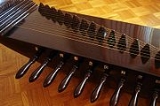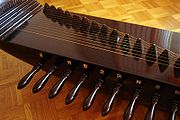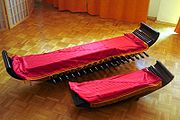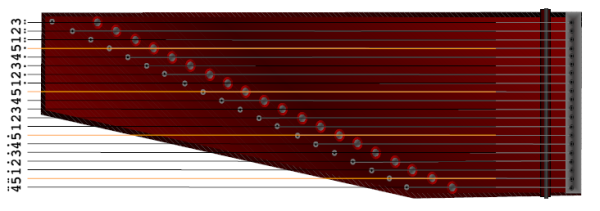
Kacapi
Encyclopedia
Kacapi is a zither
-like Sundanese
musical instrument played as the main accompanying instrument in the Tembang Sunda
or Mamaos Cianjuran, kacapi suling
(tembang Sunda
without vocal accompaniment) genre (called kecapi seruling in Indonesian
), pantun
stories recitation or an additional instrument in Gamelan Degung
performance.
Word kacapi in Sundanese also refers to santol
tree, from which initially the wood is believed to be used for building the zither instrument.
 According to its form or physical appearance, there are two kinds of kacapis:
According to its form or physical appearance, there are two kinds of kacapis:
The Kacapi Parahu is a resonance box with an uncovered underside to allow the sound out. The sides of this kind of kacapi are tapered inward from top to bottom, which gives the instrument a boat-like shape. In ancient times, it was made directly from solid wood by perforating it.
The Kacapi siter is a plan-parallel resonance box. Similar to the kacapi parahu, its hole is located at the bottom. The upper and bottom sides of it form a trapezium-like shape.
For both kinds of kacapi, each string is affixed to a small screw or peg on the top right hand side of the box. They can be tuned in different systems: pelog
, sorog/madenda, or slendro
.
Nowadays, the resonance box of kacapi is made by glueing six wood-plates side by side.
The kacapi is traditionally played by sitting cross-legged on the floor. Thus the strings are about 25 cm above the floor. Nowadays the kacapi is sometimes placed on a wooden frame, so that the player can sit on a chair. If the kacapi indung is played while sitting on the floor, usually a pillow or some other small object is placed under its left hand side, as seen from the player, so that the sound can freely escape through the resonance hole in the bottom of the soundbox. Some kecapi are fitted with small feet, so that it is not necessary to lift them in this way.

 According to its functions in a musical accompaniment, the kacapi is played as:
According to its functions in a musical accompaniment, the kacapi is played as:
The Kacapi indung leads the accompaniment by providing intros, bridges, and interludes, as well as determining the tempo. For this purpose, a large kacapi with 18 or 20 strings is used.
The Kacapi rincik enriches the accompaniment by filling in inter-note spaces with higher frequencies, especially in fixed metered songs as in the kacapi suling
or Sekar Panambih. For this purpose, a smaller kacapi with ~15 strings is used.
The note range, from the lowest to the highest frequency is:
 The kacapi is tuned to match the 60 cm length suling tones. With this length, an approximation for the tuning compared to western scale is:
The kacapi is tuned to match the 60 cm length suling tones. With this length, an approximation for the tuning compared to western scale is:
 The following picture applies the above-mentioned tuning and notation.
The following picture applies the above-mentioned tuning and notation.

stories. In the Sundanese
dictionary published by the Lembaga Basa & Sastra Sunda (1976) the primary meaning of the word pantun
is given as kacapi. This may be an indication that the relation between the kacapi and the recitation of pantun
stories is an old one. Eringa (1949:3) points to the proverb "kawas pantun teu jeung kacapi", 'like a pantun(-singer) without a kacapi', used of someone who likes to give other people advice but who does not himself practise what he preaches. This proverb, according to Eringa, indicates that the kacapi is the Standard instrument for accompanying a pantun
recitation. The Baduy Sundanese
of Banten Province still make exclusive use of the kacapi to accompany their pantun stories.
Zither
The zither is a musical string instrument, most commonly found in Slovenia, Austria, Hungary citera, northwestern Croatia, the southern regions of Germany, alpine Europe and East Asian cultures, including China...
-like Sundanese
Sundanese people
The Sundanese are an ethnic group native to the western part of the Indonesian island of Java. They number approximately 31 million, and are the second most populous of all the nation's ethncities. The Sundanese are predominantly Muslim...
musical instrument played as the main accompanying instrument in the Tembang Sunda
Tembang Sunda
Tembang sunda, also called seni mamaos cianjuran is a style of classical vocal music that originated in the Sunda Kingdom of highland west Java. Unlike Sundanese gamelan music, tembang sunda was developed in the court of the regent Kabupaten Cianjur during the Dutch colonial period...
or Mamaos Cianjuran, kacapi suling
Kacapi suling
Kacapi suling is a form of Sundanese music from West Java. It is essentially tembang Sunda minus vocals, and also at interludes between songs at a typical Tembang Sunda performance. The higher pitched kacapi rincik, the lower pitched kacapi indung and the suling flute are the instruments used for...
(tembang Sunda
Tembang Sunda
Tembang sunda, also called seni mamaos cianjuran is a style of classical vocal music that originated in the Sunda Kingdom of highland west Java. Unlike Sundanese gamelan music, tembang sunda was developed in the court of the regent Kabupaten Cianjur during the Dutch colonial period...
without vocal accompaniment) genre (called kecapi seruling in Indonesian
Indonesian language
Indonesian is the official language of Indonesia. Indonesian is a normative form of the Riau Islands dialect of Malay, an Austronesian language which has been used as a lingua franca in the Indonesian archipelago for centuries....
), pantun
Pantun Sunda
Pantun Sunda is a type of Sundanese oral narrative performance interspersed with songs and music played on a kacapi, a kind of zither. A pantun used to be recited during an evening-length performance...
stories recitation or an additional instrument in Gamelan Degung
Gamelan degung
Gamelan Degung is a Sundanese musical ensemble that uses a subset of modified gamelan instruments with a particular mode of pelog scale.- Instruments :The instrumentation of gamelan degung is quite flexible. It may include:...
performance.
Word kacapi in Sundanese also refers to santol
Santol (fruit)
The santol is a tropical fruit grown in Southeast Asia.-Origin and distribution:The santol is believed native to former Indochina and Peninsular Malaysia, and to have been introduced into India, Borneo, Indonesia, the Moluccas, Mauritius, and the Philippines where it has become naturalized...
tree, from which initially the wood is believed to be used for building the zither instrument.
Form

- Kacapi Parahu (=Boat Kacapi) or Kacapi Gelung ; and
- Kacapi Siter
The Kacapi Parahu is a resonance box with an uncovered underside to allow the sound out. The sides of this kind of kacapi are tapered inward from top to bottom, which gives the instrument a boat-like shape. In ancient times, it was made directly from solid wood by perforating it.
The Kacapi siter is a plan-parallel resonance box. Similar to the kacapi parahu, its hole is located at the bottom. The upper and bottom sides of it form a trapezium-like shape.
For both kinds of kacapi, each string is affixed to a small screw or peg on the top right hand side of the box. They can be tuned in different systems: pelog
Pelog
Pelog is one of the two essential scales of gamelan music native to Bali and Java, in Indonesia. The other scale commonly used is called slendro. Pelog has seven notes, but many gamelan ensembles only have keys for five of the pitches...
, sorog/madenda, or slendro
Slendro
Slendro is a pentatonic scale, one of the two most common scales used in Indonesian gamelan music, the other being pélog.-Tuning:...
.
Nowadays, the resonance box of kacapi is made by glueing six wood-plates side by side.
The kacapi is traditionally played by sitting cross-legged on the floor. Thus the strings are about 25 cm above the floor. Nowadays the kacapi is sometimes placed on a wooden frame, so that the player can sit on a chair. If the kacapi indung is played while sitting on the floor, usually a pillow or some other small object is placed under its left hand side, as seen from the player, so that the sound can freely escape through the resonance hole in the bottom of the soundbox. Some kecapi are fitted with small feet, so that it is not necessary to lift them in this way.

Functions

- Kacapi Indung (=mother kacapi); and
- Kacapi Anak (=child kacapi) or Kacapi Rincik
The Kacapi indung leads the accompaniment by providing intros, bridges, and interludes, as well as determining the tempo. For this purpose, a large kacapi with 18 or 20 strings is used.
The Kacapi rincik enriches the accompaniment by filling in inter-note spaces with higher frequencies, especially in fixed metered songs as in the kacapi suling
Kacapi suling
Kacapi suling is a form of Sundanese music from West Java. It is essentially tembang Sunda minus vocals, and also at interludes between songs at a typical Tembang Sunda performance. The higher pitched kacapi rincik, the lower pitched kacapi indung and the suling flute are the instruments used for...
or Sekar Panambih. For this purpose, a smaller kacapi with ~15 strings is used.
Tuning and Notation
Kacapi uses degung notation. It is a subset of the pelog heptachordal system. See the following table.| Sundanese pelog degung Gamelan degung Gamelan Degung is a Sundanese musical ensemble that uses a subset of modified gamelan instruments with a particular mode of pelog scale.- Instruments :The instrumentation of gamelan degung is quite flexible. It may include:... |
Javanese pelog Pelog Pelog is one of the two essential scales of gamelan music native to Bali and Java, in Indonesia. The other scale commonly used is called slendro. Pelog has seven notes, but many gamelan ensembles only have keys for five of the pitches... |
| 1 (da) | 6 |
| 2 (mi) | 5 |
| 3 (na) | 3 |
| 4 (ti) | 2 |
| 5 (la) | 1 |
The note range, from the lowest to the highest frequency is:



Kacapi and recitation of pantun stories
It is not certain how long the kacapi has been used to accompany the recitation of pantunPantun Sunda
Pantun Sunda is a type of Sundanese oral narrative performance interspersed with songs and music played on a kacapi, a kind of zither. A pantun used to be recited during an evening-length performance...
stories. In the Sundanese
Sundanese language
Sundanese is the language of about 27 million people from the western third of Java or about 15% of the Indonesian population....
dictionary published by the Lembaga Basa & Sastra Sunda (1976) the primary meaning of the word pantun
Pantun Sunda
Pantun Sunda is a type of Sundanese oral narrative performance interspersed with songs and music played on a kacapi, a kind of zither. A pantun used to be recited during an evening-length performance...
is given as kacapi. This may be an indication that the relation between the kacapi and the recitation of pantun
Pantun Sunda
Pantun Sunda is a type of Sundanese oral narrative performance interspersed with songs and music played on a kacapi, a kind of zither. A pantun used to be recited during an evening-length performance...
stories is an old one. Eringa (1949:3) points to the proverb "kawas pantun teu jeung kacapi", 'like a pantun(-singer) without a kacapi', used of someone who likes to give other people advice but who does not himself practise what he preaches. This proverb, according to Eringa, indicates that the kacapi is the Standard instrument for accompanying a pantun
Pantun Sunda
Pantun Sunda is a type of Sundanese oral narrative performance interspersed with songs and music played on a kacapi, a kind of zither. A pantun used to be recited during an evening-length performance...
recitation. The Baduy Sundanese
Sundanese people
The Sundanese are an ethnic group native to the western part of the Indonesian island of Java. They number approximately 31 million, and are the second most populous of all the nation's ethncities. The Sundanese are predominantly Muslim...
of Banten Province still make exclusive use of the kacapi to accompany their pantun stories.

